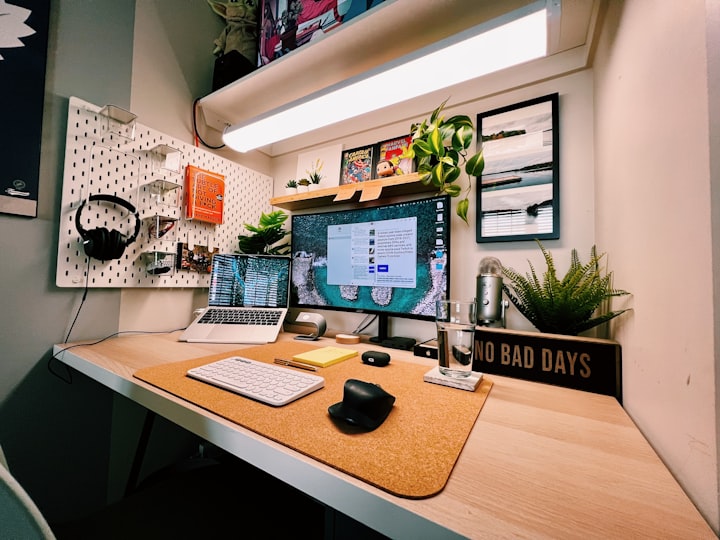3 Cheap Purchases For Insane Productivity
3 arguably unnecessary things that have drastically improved my life

Disclaimer: There are ZERO affiliate links to these products, I’ve just found them helpful to my workflow and want to provide insights about how making similar purchases might benefit yours.
We’ve all heard the story of the tortoise and the hare. Let me tell you my version where they both win.
In the scope of content creation, these two schools of thought have prevailed. On one hand, the teachings of the tortoise tell us that slow and steady wins the race. Slow productivity, taking the time to guarantee quality with our content is the only way forward.
The opposing school, the hare, promotes a hustle culture. Content is best produced quickly and in high quantities. Quality is built through the raw process of getting your reps in.
The problem with increasing speed is that you’re more prone to burning out and producing lower-quality work. The pressure is real, the moment we slow our pace is the moment someone else will surpass us. God forbid stopping completely to take a nap, as the hare’s story goes.
I use 3 items that consistently help me get the best of both worlds.
These purchases have drastically improved my hustle while also helping me avoid burnout. Everything on this list has been in constant use for months now, and my returns have only compounded, leaving me more confident with every work session.
1 — Physical alarm clock
Your phone’s alarm is incredibly easy to dismiss. Mindlessly, and repeatedly. There have been times when I won’t get out of bed until an hour or two after my alarm, not remembering the snoozing of my ten alarms I had set the night before. On days when there are more important tasks to manage, I’ve been able to wake up reliably, but in everyday life, rising late can easily snuff out the day’s creative momentum before it’s had a chance of ignition.
Having a physical alarm clock solves this in two ways. I specifically bought one that didn’t have a snooze button, which raises the stakes a bit when I’ll inevitably convince myself that I can “just close my eyes for a few more minutes.”
Yeah right.
Having a physical alarm clock will also force you out of bed if you place it away from your nightstand. I put mine at my desk, plenty of distance from my bed. Depending on the day, you’ll curse or thank yourself for it, but getting up and on your feet provides you with a way to begin each morning with physical momentum you can build on throughout your day.
There will be failures. Occasionally, I’ll set my alarm clock next to my bed after convincing myself I’ll be more than well-rested by the time it rings, only to have an easier time turning it off and going back to bed.
There are other times when I’ve already sunk face into pillow before setting my alarm. If I’m too tired to get up, I’ll set alarms on my phone instead which defeats the whole purpose and opens you back up to all the aforementioned shortcomings.
If you’re looking to ensure a head start on the day, having a physical alarm clock might be the right move for you. The wooden analog one I bought only set me back $20, is virtually silent and comes with a night light (that I have yet to make use of).
And it looks classy as hell.
But unnecessary, nothing is stopping me from setting my phone alarm then tossing it across the room before drifting off to sleep.
I’ve just made it a habit to fall asleep listening to various podcasts and video content. Tough to break that one — having a physical alarm clock helps me wake up faster and more reliably.
2 — Custom mechanical keyboard
This is the one purchase that has improved my productivity the most. Previous to building my keyboard, the thought of owning a mechanical keyboard has always left me disenchanted about how it could fit in my workflow. They’re loud, clicky, and the keys can be bulkier and more difficult to type on compared to the “normal” flat keys you’d find on laptops and cheap Bluetooth keyboards.
All these concerns were valid, there were mechanical keyboards out there that objectively looked and sounded gross. I didn’t want anything to do with that. But when I took more time to research what makes a mechanical keyboard personal, I realized that I had way more options.
I won’t bore you with all the tech-nerd speak (by now I’ve been fully indoctrinated into mechanical keyboard culture and am thoroughly enjoying it), but I was able to customize and modify my keyboard to get the perfect deep thocks¹ with every keystroke while getting the perfect keycaps and walnut wooden case to make the whole setup feel more organic than it had before.
Before I tore out each page for an impromptu weekend art project, I had read about the relationship that mechanics had with their labor in Matthew Crawford’s Shop Class As Soulcraft. The act of working with your hands to solve a problem, and to see physical proof that your efforts were worth it is rewarding in the world of auto shops, but so too in personal mechanical keyboard builds.
Typing has become addictive and productive.
Having the tactile and sonic feedback of the keys while you bring your ideas to life has drastically lifted the air of actually doing the work. I’m sure there’s some real psychology to this, but I’ve noticed that I have an easier time getting into the flow state while I’m writing without compromising on quality. With my custom keyboard, I’ve leveraged the intersection of where the aesthetic meets the functional, and using it every day has turned the act of writing into its own reward.
I’ve recently converted my sister into the church of mechanical keyboards, and she’s built one that sounds better than mine and looks very clean and industrious. They’re a bit more on the expensive side if you want to dive in — my rig was around $250, but I wouldn’t want to compromise the aesthetic I had set out to create. My sister’s keyboard was closer to $100 for an arguably better result.
I’m not jealous.
Or until I build another keyboard, I’ll keep telling myself that.
Relatively inexpensive mechanical keyboards can also be great right out of the box and can take your desk workflow up another notch when you take the time to tailor it to your taste. Despite these advantages, a mechanical keyboard is just a glorified version of what a PC or laptop can be. Completely unnecessary, but knowing the spoils of my effort, I can’t see myself ever going back.
3 — LEUCHTTURM1917, a journal recommended by Neil Gaiman
I’ve written about the benefits of journaling before.² What I haven’t mentioned yet is just how important paper quality can be. My first journal was a gift, has nice paper and cover material that’s meant to be timeless — a hardy matte paper stock that feels almost like leather. Unfortunately, it’s been discontinued.
For as much as I’ve interacted with Neil Gaiman, I have yet to read Neil Gaiman. I’ve taken his Masterclass on fiction writing, and have just recently listened to a 90-minute interview on Tim Ferriss’ podcast. Towards the beginning of their conversation, Ferriss asks Gaiman about his drafting process. He says he drafts every novel with a fountain pen and a solid journal. I’m not too big a fan of the fountain pen — given my dexterity, I’d find a way to spill any open ink container, but the specific notebook Gaiman spoke of was the LEUCHTTURM1917, calling them
"The Porsche of Moleskins–they’re just better."
Neil Gaiman isn’t wrong. Neil Gaiman is never wrong.
The LEUCHTTURM’s pages are thick
No matter the exterior, the interior of a journal makes or breaks its quality. I’ve already committed myself to filling up a Moleskin I bought a few years ago. I’ve always treated reflection with a sacred air — using a journal with thin paper is a disservice to your ideas and the processes that surround them. When investing in a vessel that can help transform your ideas into real-world things, best you don’t skimp on the quality. Without sounding too much like an ad, the LEUCHTTURM1917 sports ultra-sturdy 120g/m² paper that can withstand the demands of high-impact writing.
Brilliant.
They’ll be around for a while
A pet peeve of mine about the discontinued journal I’ve written in was that I couldn’t go a get another one without overpaying someone from a deep corner of the internet. The Leuchtturm brand is one that’s existed as a pioneer in the space for over a century. It isn’t going anywhere anytime soon. Knowing that I can return to a brand whose belief in the sanctity of written ideas and product quality has remained stable for so long has reassured me that I can properly house my future ideas.
I am trying to speed through the remainder of my Moleskin, though!
A LEUCHTTURM1917 will set you back $25. An easy choice I’ll continue to make until the end of time, barring some unforeseen wunderkind journal that redefines the entire industry.
The verdict
While none of these products are necessary to your productivity, I have found that they’ve done a great deal to help keep me on track by providing me more incentive to interact meaningfully with my possessions.
My phone alarms were unreliable and easy to snooze. Having a physical alarm clock has made it easier to get out of bed.
My cheap Bluetooth keyboard got the job done, but my customized mechanical keyboard is something I continue to take great pride in typing on.
Moleskins can get you to point A to point B, but your mileage is better spent in the LEUCHTTURM1917’s company.
I hope my insights have given you ideas about how to improve your workflow. While more common equipment and a good work ethic can create a perfectly functional creative environment, I firmly believe that investing in any one of the tools I mentioned here can help take your work to the next level.
Disclaimer: This article was originally published on Medium.
Here's a link to the original article:
https://medium.com/illumination/3-cheap-purchases-for-insane-productivity-e6f44337fc0a
About the Creator
Justin Boyette
4x Top Writer on Medium. Telling interesting stories from life's ordinary moments.
Writing about learning, organization, and erudition.






Comments
There are no comments for this story
Be the first to respond and start the conversation.